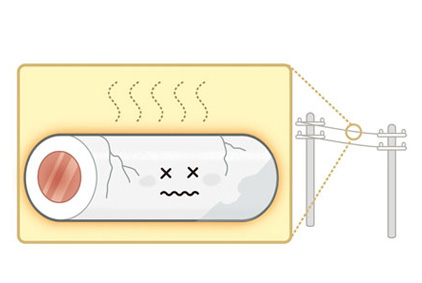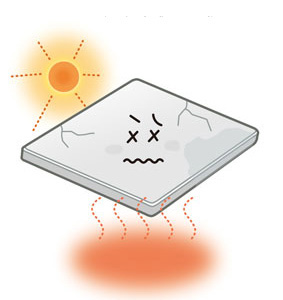Common Problems and Selection of Additives
Common problems during molding and production processes and the corrective measures are explained below. Please refer to the information below when selecting additives.
Frequently Asked Questions
- Influence of
Additives
during Molding - Extension of
Heat Stability - Extension of
Weathering
Stability - Discoloration
- Impairment of
Design Aesthetics
-
Extension of Heat Stability
Q4
How to prevent shortening of heat stability in applications in which plastics are in contact with metal or metal ions?
A4
 Insufficient heat stability
In applications in which plastics are in contact with metal such as copper (Cu) or iron (Fe) (for example, cables containing copper wire or pigments containing metals), degradation of the plastic may be accelerated. Hydroperoxide is produced when plastics are exposed to heat or light during processing and use, this process being catalyzed by metal ions, which accelerate radical formation through the redox reaction (oxidation-reduction reaction), thereby promoting degradation and shortening the life of the plastic:
Insufficient heat stability
In applications in which plastics are in contact with metal such as copper (Cu) or iron (Fe) (for example, cables containing copper wire or pigments containing metals), degradation of the plastic may be accelerated. Hydroperoxide is produced when plastics are exposed to heat or light during processing and use, this process being catalyzed by metal ions, which accelerate radical formation through the redox reaction (oxidation-reduction reaction), thereby promoting degradation and shortening the life of the plastic:
Corrective Measures
- 1
- To stabilize the plastic, use a heavy metal deactivator (such as ADK STAB CDA-1 and CDA-10) to chelate and thereby scavenge the metal ions responsible for degradation. Typical metal deactivator products on the market are amide compounds, such as oxalic acid and salicylic acid derivatives, and hydrazide compounds. Heavy Metal Deactivator
- 2
- Heavy metal deactivators have no stabilizing effect. Hence, in applications in which thermal stability is required, metal deactivators should be used in combination with phenolic (ADK STAB AO-60, AO-50, AO-80, etc.), thioether (ADK STAB AO-412S) or phosphorous (ADK STAB 2112 and HP-10) antioxidants, etc. In applications in which weatherability is required, metal deactivators should be used in combination with an ultraviolet absorber or hindered amine light stabilizer (HALS).
Q5
How to prevent acceleration of degradation during high temperature use?
A5
 Prevention of accelerated degradation
When used at higher temperatures, plastics are more prone to degrade, since the autoxidation reaction is accelerated.
Prevention of accelerated degradation
When used at higher temperatures, plastics are more prone to degrade, since the autoxidation reaction is accelerated.
Corrective Measures
- 1
- It is effective to use not only phenolic or phosphorous antioxidants, but also a thioether antioxidant (ADK STAB AO-412S etc.) in combination.
The List of AO series
- 2
- Care needs to be exercised, since, after emitting an odor or exhibiting their stabilizing effect, thioether antioxidants may produce an acidic substance etc.
- 3
- Since additives volatilize more readily at higher temperatures, they should be selected—according to their molecular weight and compatibility, etc.—so as to be suitable for the environment in which the products will be used.
